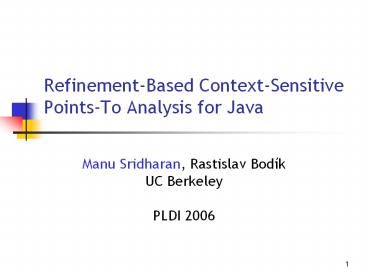Refinement-Based Context-Sensitive Points-To Analysis for Java - PowerPoint PPT Presentation
1 / 18
Title:
Refinement-Based Context-Sensitive Points-To Analysis for Java
Description:
Fully precise in the limit. Only small amount of code analyzed precisely ... More precise for tested clients. Interactive performance for queries ... – PowerPoint PPT presentation
Number of Views:22
Avg rating:3.0/5.0
Title: Refinement-Based Context-Sensitive Points-To Analysis for Java
1
Refinement-Based Context-Sensitive Points-To
Analysis for Java
- Manu Sridharan, Rastislav Bodík
- UC Berkeley
- PLDI 2006
2
What Does Refinement Buy You?
- Increased scalability enable new clients
- Memory orders of magnitude savings
- Time answer for a variable comes back in 1
second - ) Suitable for IDE
Cast Safety Client
Precision
3
Approach Focus on the Client
- Demand-driven only do requested work
- Client-driven refinement stop when client
satisfied - Example
- client asks can x point to o?
- we refine until we answer NO (the good answer) or
we time out
4
Context-Sensitive Analysis Costly
- Context-sensitive analysis (def)
- Compute result as if all calls inlined
- But, collapse recursive methods
- Exponential blowup (code growth)
5
Why Not Existing Technique?
- Most analyses approximate same way in all code
- E.g., k-CFA
- Precision lost, esp. for data structures
- Our analysis focuses precision where it matters
- Fully precise in the limit
- Only small amount of code analyzed precisely
- First refinement algorithm for Java
6
Points-To Analysis Overview
- Compute objects each variable can point to
- For each var x, points-to set pt(x)
- Model objects with abstract locations
- 1 x new Foo() yields pt(x) o1
- Flow-insensitive statements in any order
7
Points-To Analysis as CFL-Reachability
1) Assignments x new Obj() // o1 y new
Obj() // o2 z x
o1
x
z
a
2) Method calls id(p) return p a id(x) b
id(y)
(1
)1
f
f
pid
retid
d
c
g
)2
(2
3) Heap accesses c.f x c.g y d c.f
y
o2
b
- pt(x) o o flowsTo x
flowsTo path exists
flowsTo balanced call and field parens
flowsTo balanced call parens
8
Summary of Formulation
- Graph represents program
- Compute reachability with two filters
- Language of balanced call parens
- Language of balanced field parens
9
Single path problem
t9
t7
j
p
t8
)8
t6
t5
)5
(7
(1
)1
o
x
t0
t1
t2
h
f
t12
k
f (1 )1 h
g
o2
t10
- Problem show path is unbalanced
- Goal reduce number of visited edges
- Insight enough to find one unbalanced paren
t11
10
Approximation via Match Edges
o
t3
t0
t1
t2
t4
x
g
h
h
f
j
f
f g h h j f
- Match edges connect matched field parens
- From source of open to sink of close
- Initially, all pairs connected
- Use match edges to skip subpaths
11
Refining the Approximation
o
t3
t0
t1
t4
x
g
f
j
f
f g h h j f
- Refine by removing some match edges
- Exposes more of original path for checking
- Soundness Traverse match edge ) assume
field parens balanced on skipped path - Remove where unbalanced parens expected
- Explore deeper levels of pointer indirection
12
Refinement With Both Languages
(2
)3
(1
)1
o
t5
t0
t1
t2
t6
x
t3
t4
g
g
f
f
Fields f g g f
Calls (1 )1 (2 )3
- Match edges enable approximation of calls
- Only can check calls on match-free subpaths
- Match edge removal ) more call checking
- Key point refine heap and calls together
13
Evaluation
14
Experimental Configuration
- Implemented in Soot framework
- Tested on large benchmarks x 2 clients
- SPECjvm98, Dacapo suite
- Downcast checking, factory method props
- Refine context-insensitive result
- Timeout for long-running queries
15
Precision Cast Checking
16
Scalability Time and Memory
- Average query time less than 1 second
- Interactive performance (for IDE)
- At most 13 minutes for casts, 4 minutes for
factory client - Very low memory usage at most 35MB
- Of this, 30MB for context-insensitive result
- Compare with gt2GB for 1-ObjSens analysis
17
Demand-Driven vs. Exhaustive
- Demand advantage no caching required
- Hence, low memory overhead
- No engineering of efficient sets
- Good for changing code just re-compute
- Demand advantage faster for many clients
- Often only care about some variables
- Demand disadvantage slower querying all vars
- At most 90 minutes for all app. vars
- But, still good precision, memory
18
Conclusions
- Novel refinement-based analysis
- More precise for tested clients
- Interactive performance for queries
- Low memory could scale even more
- Relatively easy to implement
- Insight refine heap and calls together
- Useful for other balanced-paren analyses?































